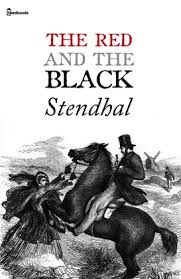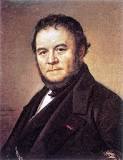The Red and the Black Page #4
Le Rouge et le Noir is a historical psychological novel in two volumes by Stendhal, published in 1830. It chronicles the attempts of a provincial young man to rise socially beyond his modest upbringing through a combination of talent, hard work, deception, and hypocrisy.
And if the traveller stops a few minutes in that Grande-Rue of Verrières which goes on an upward incline from the bank of the Doubs to nearly as far as the summit of the hill, it is a hundred to one that he will see a big man with a busy and important air. When he comes in sight all hats are quickly taken off. His hair is grizzled and he is dressed in grey. He is a Knight of several Orders, has a large forehead and an aquiline nose, and if you take him all round, his features are not devoid of certain regularity. One might even think on the first inspection that it combines with the dignity of the village mayor that particular kind of comfortableness which is appropriate to the age of forty-eight or fifty. But soon the traveller from Paris will be shocked by a certain air of self-satisfaction and self-complacency mingled with an almost indefinable narrowness and lack of inspiration. One realises at last that this man's talent is limited to seeing that he is paid exactly what he is owed, and in paying his own debts at the latest possible moment. Such is M. de Rênal, the mayor of Verrières. After having crossed the road with a solemn step, he enters the mayoral residence and disappears from the eye of the traveller. But if the latter continues to walk a hundred steps further up, he will perceive a house with a fairly fine appearance, with some magnificent gardens behind an iron grill belonging to the house. Beyond that is an horizon line formed by the hills of Burgundy, which seem ideally made to delight the eyes. This view causes the traveller to forget that pestilential atmosphere of petty money-grubbing by which he is beginning to be suffocated. He is told that this house belongs to M. de Rênal. It is to the profits which he has made out of his big nail factory that the mayor of Verrières owes this fine residence of hewn stone which he is just finishing. His family is said to be Spanish and ancient, and is alleged to have been established in the country well before the conquest of Louis XIV. Since 1815, he blushes at being a manufacturer: 1815 made him mayor of Verrières. The terraced walls of this magnificent garden which descends to the Doubs, plateau by plateau, also represent the reward of M. de Rênal's proficiency in the iron-trade. Do not expect to find in France those picturesque gardens which surround the manufacturing towns of Germany, like Leipsic, Frankfurt and Nurenburgh, etc. The more walls you build in Franche-Comté and the more you fortify your estate with piles of stone, the more claim you will acquire on the respect of your neighbours. Another reason for the admiration due to M. de Rênal's gardens and their numerous walls, is the fact that he has purchased, through sheer power of the purse, certain small parcels of the ground on which they stand. That saw-mill, for instance, whose singular position on the banks of the Doubs struck you when you entered Verrières, and where you notice the name of SOREL written in gigantic characters on the chief beam of the roof, used to occupy six years ago that precise space on which is now reared the wall of the fourth terrace in M. de Rênal's gardens. Proud man that he was, the mayor had none the less to negotiate with that tough, stubborn peasant, old Sorel. He had to pay him in good solid golden louis before he could induce him to transfer his workshop elsewhere. As to the public stream which supplied the motive power for the saw-mill, M. de Rênal obtained its diversion, thanks to the influence which he enjoyed at Paris. This favour was accorded him after the election of 182-. He gave Sorel four acres for every one he had previously held, five hundred yards lower down on the banks of the Doubs. Although this position was much more advantageous for his pine-plank trade, father Sorel (as he is called since he has become rich) knew how to exploit the impatience and mania for landed ownership which animated his neighbour to the tune of six thousand francs. It is true that this arrangement was criticised by the wiseacres of the locality. One day, it was on a Sunday four years later, as M. de Rênal was coming back from church in his mayor's uniform, he saw old Sorel smiling at him, as he stared at him some distance away surrounded by his three sons. That smile threw a fatal flood of light into the soul of the mayor. From that time on, he is of opinion that he could have obtained the exchange at a cheaper rate. In order to win the public esteem of Verrières it is essential that, though you should build as many walls as you can, you should not adopt some plan imported from Italy by those masons who cross the passes of the Jura in the spring on their way to Paris. Such an innovation would bring down upon the head of the imprudent builder an eternal reputation for wrongheadedness, and he will be lost for ever in the sight of those wise, well-balanced people who dispense public esteem in Franche-Comté. As a matter of fact, these prudent people exercise in the place the most offensive despotism. It is by reason of this awful word, that anyone who has lived in that great republic which is called Paris, finds living in little towns quite intolerable. The tyranny of public opinion (and what public opinion!) is as stupid in the little towns of France as in the United States of America. CHAPTER II A MAYOR Importance! What is it, sir after all? The respect of fools, the wonder of children, the envy of the rich, the contempt of the wise man.--Barnave Happily for the reputation of M. de Rênal as an administrator an immense wall of support was necessary for the public promenade which goes along the hill, a hundred steps above the course of the Doubs. This admirable position secures for the promenade one of the most picturesque views in the whole of France. But the rain water used to make furrows in the walk every spring, caused ditches to appear, and rendered it generally impracticable. This nuisance, which was felt by the whole town, put M. de Rênal in the happy position of being compelled to immortalise his administration by building a wall twenty feet high and thirty to forty yards long. The parapet of this wall, which occasioned M. de Rênal three journeys to Paris (for the last Minister of the Interior but one had declared himself the mortal enemy of the promenade of Verrières), is now raised to a height of four feet above the ground, and as though to defy all ministers whether past or present, it is at present adorned with tiles of hewn stone. How many times have my looks plunged into the valley of the Doubs, as I thought of the Paris balls which I had abandoned on the previous night, and leant my breast against the great blocks of stone, whose beautiful grey almost verged on blue. Beyond the left bank, there wind five or six valleys, at the bottom of which I could see quite distinctly several small streams. There is a view of them falling into the Doubs, after a series of cascades. The sun is very warm in these mountains. When it beats straight down, the pensive traveller on the terrace finds shelter under some magnificent plane trees. They owe their rapid growth and their fine verdure with its almost bluish shade to the new soil, which M. the mayor has had placed behind his immense wall of support for (in spite of the opposition of the Municipal Council) he has enlarged the promenade by more than six feet (and although he is an Ultra and I am a Liberal, I praise him for it), and that is why both in his opinion and in that of M. Valenod, the fortunate Director of the workhouse of Verrières, this terrace can brook comparison with that of Saint-Germain en Laye.
Translation
Translate and read this book in other languages:
Select another language:
- - Select -
- 简体中文 (Chinese - Simplified)
- 繁體中文 (Chinese - Traditional)
- Español (Spanish)
- Esperanto (Esperanto)
- 日本語 (Japanese)
- Português (Portuguese)
- Deutsch (German)
- العربية (Arabic)
- Français (French)
- Русский (Russian)
- ಕನ್ನಡ (Kannada)
- 한국어 (Korean)
- עברית (Hebrew)
- Gaeilge (Irish)
- Українська (Ukrainian)
- اردو (Urdu)
- Magyar (Hungarian)
- मानक हिन्दी (Hindi)
- Indonesia (Indonesian)
- Italiano (Italian)
- தமிழ் (Tamil)
- Türkçe (Turkish)
- తెలుగు (Telugu)
- ภาษาไทย (Thai)
- Tiếng Việt (Vietnamese)
- Čeština (Czech)
- Polski (Polish)
- Bahasa Indonesia (Indonesian)
- Românește (Romanian)
- Nederlands (Dutch)
- Ελληνικά (Greek)
- Latinum (Latin)
- Svenska (Swedish)
- Dansk (Danish)
- Suomi (Finnish)
- فارسی (Persian)
- ייִדיש (Yiddish)
- հայերեն (Armenian)
- Norsk (Norwegian)
- English (English)
Citation
Use the citation below to add this book to your bibliography:
Style:MLAChicagoAPA
"The Red and the Black Books." Literature.com. STANDS4 LLC, 2025. Web. 8 Mar. 2025. <https://www.literature.com/book/the_red_and_the_black_201>.








Discuss this The Red and the Black book with the community:
Report Comment
We're doing our best to make sure our content is useful, accurate and safe.
If by any chance you spot an inappropriate comment while navigating through our website please use this form to let us know, and we'll take care of it shortly.
Attachment
You need to be logged in to favorite.
Log In